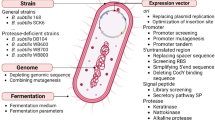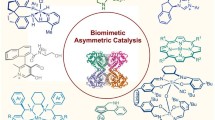Abstract
Promiscuous enzymes can be modified by protein engineering, which enables the catalysis of non-native substrates. γ-lactamase Sspg from Sulfolobus solfataricus is an enzyme with high activity, high stability, and pronounced tolerance of high concentrations of the γ-lactam substrate. These characteristics suggest Sspg as a robust enzymatic catalyst for the preparation of optically pure γ-lactam. This study investigated the modification of this enzyme to expand its application toward resolving chiral esters. γ-Lactamase-esterase conversion was performed by employing a three-step method: initial sequence alignment, followed by substrate screening, and protein engineering based on the obtained substrate-enzyme docking results. This process of fine-tuning of chemical groups on substrates has been termed “substrate screening.” Steric hindrance and chemical reactivity of the substrate are major concerns during this step, since both are determining factors for the enzyme-substrate interaction. By employing this three-step method, γ-lactamase Sspg was successfully converted into an esterase with high enantioselectivity towards phenylglycidate substrates (E value > 300). However, since both wild-type Sspg and Sspg mutants did not hydrolyze para-nitrophenyl substrates (pNPs), this esterase activity was termed “atypical esterase activity.” The γ-lactamase activity and stability of the Sspg mutants were not severely compromised. The proposed method can be applied to find novel multi-functional enzyme catalysts within existing enzyme pools.





Similar content being viewed by others
References
Aharoni A, Gaidukov L, Khersonsky O, Gould SM, Roodveldt C, Tawfik DS (2005) The ‘evolvability’ of promiscuous protein functions. Nat Genet 37(1):73–76. https://doi.org/10.1038/ng1482
Altschul SF, Gish W, Miller W, Myers EW, Lipman DJ (1990) Basic local alignment search tool. J Mol Biol 215(3):403–410. https://doi.org/10.1006/jmbi.1990.9999S0022-2836(05)80360-2
Arpigny JL, Jaeger KE (1999) Bacterial lipolytic enzymes: classification and properties. Biochem J 343(1):177–183
Bornscheuer UT, Kazlauskas RJ (2004) Catalytic promiscuity in biocatalysis: using old enzymes to form new bonds and follow new pathways. Angew Chem Int Ed Eng 43(45):6032–6040. https://doi.org/10.1002/anie.200460416
Chen CS, Wu SH, Girdaukas G, Sih CJ (1987) Quantitative analyses of biochemical kinetic resolution of enantiomers. 2. Enzyme-catalyzed esterifications in water-organic solvent biphasic systems. ChemInform 109(36):2812–2817
Cilia E, Fabbri A, Uriani M, Scialdone GG, Ammendola S (2005) The signature amidase from Sulfolobus solfataricus belongs to the CX3C subgroup of enzymes cleaving both amides and nitriles. Ser195 and Cys145 are predicted to be the active site nucleophiles. FEBS J 272(18):4716–4724. https://doi.org/10.1111/j.1742-4658.2005.04887.x
Gao P, Wu S, Praveen P, Loh KC, Li Z (2016) Enhancing productivity for cascade biotransformation of styrene to (S)-vicinal diol with biphasic system in hollow fiber membrane bioreactor. Appl Microbiol Biotechnol 101:1857–1868. https://doi.org/10.1007/s00253-016-7954-1
Hogrefe HH, Cline J, Youngblood GL, Allen RM (2002) Creating randomized amino acid libraries with the QuikChange (R) Multi Site-Directed Mutagenesis Kit. Biotechniques 33(5):1158–1165
Holmquist M (2000) Alpha/Beta-hydrolase fold enzymes: structures, functions and mechanisms. Curr Protein Pept Sci 1(2):209–235
Hult K, Berglund P (2007) Enzyme promiscuity: mechanism and applications. Trends Biotechnol 25(5):231–238. https://doi.org/10.1016/j.tibtech.2007.03.002
Kazlauskas RJ (2005) Enhancing catalytic promiscuity for biocatalysis. Curr Opin Chem Biol 9(2):195–201. https://doi.org/10.1016/j.cbpa.2005.02.008
Khersonsky O, Tawfik DS (2010) Enzyme promiscuity: a mechanistic and evolutionary perspective. Annu Rev Biochem 79:471–505. https://doi.org/10.1146/annurev-biochem-030409-143718
Laemmli UK (1970) Cleavage of structural proteins during the assembly of the head of bacteriophage T4. Nature 227(5259):680–685
Li H, Chen C, Cao X (2015) Essential oils-oriented chiral esters as potential pesticides: asymmetric syntheses, characterization and bio-evaluation. Ind Crop Prod 76:432–436. https://doi.org/10.1016/j.indcrop.2015.07.027
Line K, Isupov MN, Littlechild JA (2004) The crystal structure of a (-) gamma-lactamase from an Aureobacterium species reveals a tetrahedral intermediate in the active site. J Mol Biol 338(3):519–532. https://doi.org/10.1016/j.jmb.2004.03.001
Mitsukura K, Shimizu M, Matsushita K, Yoshida T, Nagasawa T (2010) Characteristics and function of Alcaligenes sp. NBRC 14130 esterase catalysing the stereo-selective hydrolysis of ethyl chrysanthemate. J Appl Microbiol 108(4):1263–1270. https://doi.org/10.1111/j.1365-2672.2009.04522.x
Nishizawa M, Gomi H, Kishimoto F (1993) Purification and some properties of carboxylesterase from Arthrobacter globiformis; stereoselective hydrolysis of ethyl chrysanthemate. Agric Biol Chem 57(4):594–598
O’Brien PJ, Herschlag D (1999) Catalytic promiscuity and the evolution of new enzymatic activities. Chem Biol 6(4):R91–R105. https://doi.org/10.1016/S1074-5521(99)80033-7
Shin S, Lee TH, Ha NC, Koo HM, Kim SY, Lee HS, Kim YS, Oh BH (2002) Structure of malonamidase E2 reveals a novel Ser-cisSer-Lys catalytic triad in a new serine hydrolase fold that is prevalent in nature. EMBO J 21(11):2509–2516. https://doi.org/10.1093/emboj/21.11.2509
Singh R, Vince R (2012) 2-Azabicyclo[2.2.1]hept-5-en-3-one: chemical profile of a versatile synthetic building block and its impact on the development of therapeutics. Chem Rev 112(8):4642–4686. https://doi.org/10.1021/cr2004822
Sun Y, Zhao H, Wang J, Zhu J, Wu S (2015) Identification and regulation of the catalytic promiscuity of (-)-gamma-lactamase from Microbacterium hydrocarbonoxydans. Appl Microbiol Biotechnol 99(18):7559–7568. https://doi.org/10.1007/s00253-015-6503-7
Thompson JD, Higgins DG, Gibson TJ (1994) CLUSTAL W: improving the sensitivity of progressive multiple sequence alignment through sequence weighting, position-specific gap penalties and weight matrix choice. Nucleic Acids Res 22(22):4673–4680
Torres LL, Schliessmann A, Schmidt M, Silva-Martin N, Hermoso JA, Berenguer J, Bornscheuer UT, Hidalgo A (2012) Promiscuous enantioselective (-)-gamma-lactamase activity in the Pseudomonas fluorescens esterase I. Org Biomol Chem 10(17):3388–3392. https://doi.org/10.1039/c2ob06887g
Wang J, Zhang X, Min C, Wu S, Zheng G (2011) Single-step purification and immobilization of γ-lactamase and on-column transformation of 2-azabicyclo [2.2.1] hept-5-en-3-one. Process Biochem 46(1):81–87
Wang J, Zhu J, Wu S (2015) Immobilization on macroporous resin makes E. coli RutB a robust catalyst for production of (-) Vince lactam. Appl Microbiol Biotechnol 99(11):4691–4700. https://doi.org/10.1007/s00253-014-6247-9
Wei C, Ling J, Shen H, Zhu Q (2014) Bioresolution production of (2R,3S)-ethyl-3-phenylglycidate for chemoenzymatic synthesis of the Taxol C-13 side chain by Galactomyces geotrichum ZJUTZQ200, a new epoxide-hydrolase-producing strain. Molecules 19(6):8067–8079. https://doi.org/10.3390/molecules19068067
Xue S-S, Zhao M, Lan J-X, Ye R-R, Li Y, Ji L-N, Mao Z-W (2016) Enantioselective hydrolysis of amino acid esters by non-chiral copper complexes equipped with bis (β-cyclodextrin)s. J Mol Catal A Chem 424:297–303. https://doi.org/10.1016/j.molcata.2016.09.009
Yan X, Wang J, Sun Y, Zhu J, Wu S (2016) Facilitating the evolution of esterase activity from a promiscuous enzyme (Mhg) with catalytic functions of amide hydrolysis and carboxylic acid perhydrolysis by engineering the substrate entrance tunnel. Appl Environ Microbiol 82(22):6748–6756. https://doi.org/10.1128/AEM.01817-16
Yin JG, Gong Y, Zhang XY, Zheng GW, Xu JH (2016) Green access to chiral Vince lactam in a buffer-free aqueous system using a newly identified substrate-tolerant (-)-gamma-lactamase. Catal Sci Technol 6(16):6305–6310. https://doi.org/10.1039/c6cy00786d
Zhao H, Caflisch A (2014) Discovery of dual ZAP70 and Syk kinases inhibitors by docking into a rare C-helix-out conformation of Syk. Bioorg Med Chem Lett 24(6):1523–1527
Zheng G, Yuan Q, Yang L, Zhang X, Wang J, Sun W (2006) Preparation of (2S, 3R)-methyl-3-phenylglycidate using whole cells of Pseudomonas putida. J Mol Catal B Enzym 43(1–4):133–136. https://doi.org/10.1016/j.molcatb.2006.07.010
Zhou D, Pan J, Yu H, Zheng G, XU J (2013) Target-oriented discovery of a new esterase-producing strain Enterobacter sp. ECU1107 for whole cell-catalyzed production of (2S,3R)-3-phenylglycidate as a chiral synthon of Taxol. Appl Microbiol Biotechnol 97(14):6293–6300. https://doi.org/10.1007/s00253-012-4435-z
Funding
This study was funded by a grant from the National Natural Science Foundation of China (No. 31570077 to SW).
Author information
Authors and Affiliations
Corresponding author
Ethics declarations
Conflict of Interest
The authors declare that they have no conflict of interest.
Ethical approval
This article does not contain any studies with human participants or animals performed by any of the authors.
Additional information
Publisher’s note
Springer Nature remains neutral with regard to jurisdictional claims in published maps and institutional affiliations.
Electronic supplementary material
ESM 1
(PDF 357 kb)
Rights and permissions
About this article
Cite this article
Wang, J., Zhao, H., Zhao, G. et al. Enhancing the atypical esterase promiscuity of the γ-lactamase Sspg from Sulfolobus solfataricus by substrate screening . Appl Microbiol Biotechnol 103, 4077–4087 (2019). https://doi.org/10.1007/s00253-019-09758-3
Received:
Accepted:
Published:
Issue Date:
DOI: https://doi.org/10.1007/s00253-019-09758-3




